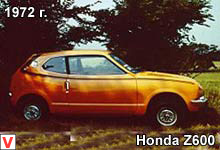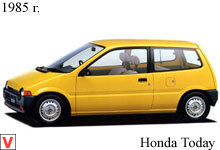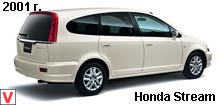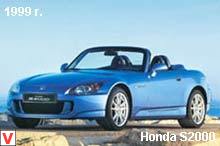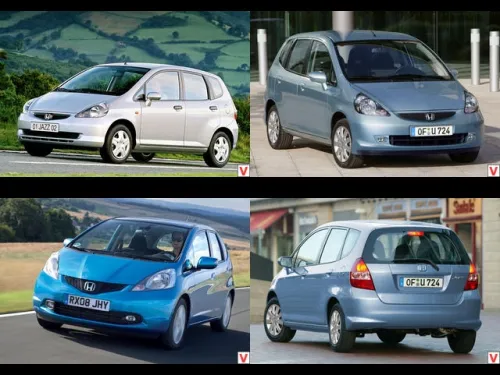
In 2001, Honda expanded the class B segment of the car by presenting a new Jazz model to the public. The Logo preceding it did not have much success. The novelty received the old-new name Jazz - so in the mid-80s a small city car was called. The European premiere of Honda Jazz took place in 2003 in Frankfurt. By the way, in Japan, it bears the name of Fit. Built car on the new platform of Honda. It is difficult to uniquely identify the body of the Jazz, as it combines the features of a hatchback, micro van, minivan, so it is often accepted to characterize the car as a compact wagon of increased capacity.
The body is made according to a long-tried and tested scheme. The hood line flows smoothly into the windshield, and the roof line ends abruptly at the back door. But the traditional decision did not prevent the car to be recognizable. In the city flow, the Jazz stands out with such original details of its exterior as a ribbed hood and spotlights under large transparent caps. The rear lights are composed of three parts: the red halves are separated by a transparent insert with two cylinders: turn signals and a reversing light.
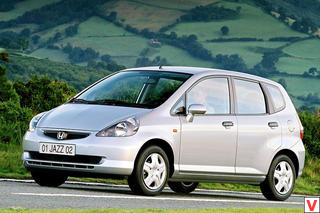
In terms of exterior dimensions, the Honda Jazz is 3.82 m long, 1.67 m wide, and 1.45 m high. However, due to the minivan body structure, it even surpasses the “golf class” cars in terms of internal volume, despite the fact that it stands a step below them. This is due to the one and a half meter high machine and vertical landing.
The compactness of the suspension and the small thickness of the seats also contribute to an increase in the useful space of the cabin. Honda specialists managed to provide the car with a spacious trunk by moving the gas tank under the cargo compartment floor under the floor of the front part of the cabin. The interior also has a share of creative solutions. The instrument panel consists of three large dials: speedometer, tachometer and fuel gauge.
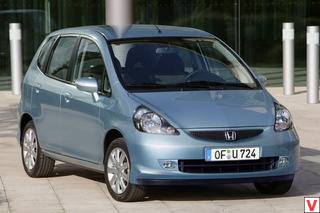
The rest of the useful information about the functioning of the units give out the warning lamps. The devices are hidden in deep mines with a matt-aluminum frame. In addition, a solid sun visor is raised above them. In the cabin there was a lot of space for small various luggage. Convenient shelf under the dashboard, extending the entire width of the cabin. Little things that it is better to hide from the eyes of outsiders, can be placed in a two-story "glove compartment" or door pockets.
The inner space of the Jazz is perfectly thought out and equipped with the maximum amount of comfort. Excellent visibility provides a large glass area and high seating. The car has a small turning radius - 4.7 meters. At the Jazz set 1.4-liter 83-strong and 1.2-liter 78-strong engines of the new i-DSI family (Dual & Sequential Ignition - sequential double ignition). A feature of this engine was the use of two spark plugs for each cylinder, which allows for complete and efficient combustion of fuel, while at the same time ensuring high efficiency and moderate consumption of gasoline.
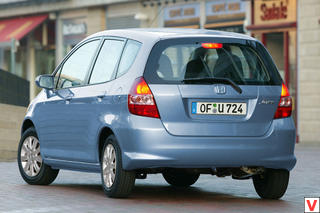
It is worth noting the excellent work of the five-speed gearbox: you rarely see similar clarity of switching and small moves of the gearshift lever on small cars. In addition to the manual gearbox, as an option, a CVT CVT can be installed on a vehicle that is similar in design to that used on an SUV. In this case, the transmission has seven fixed levels, and its controls are placed on the steering wheel. This option is available to customers since the summer of 2003. Engines of a similar design for a long time are a kind of "calling card" of the Italian Alfa Romeo.
Equipped with electric power steering has an adaptive algorithm of work, "heavier" at high speeds and becoming easier at low. The traditional McPherson type front suspension and a twisted beam on the rear trailing arms in combination with an impressive wheelbase provide a good level of comfort when driving. Front ventilated discs are installed, and rear drum brakes. Their work is supported by ABS and EBD. 175/65 R14 tires are installed as standard, and 185/55 R15 are offered for the sports version of SE Sport. The car is equipped with an audio system, air conditioning, power, four airbags and many other pleasant and useful options.
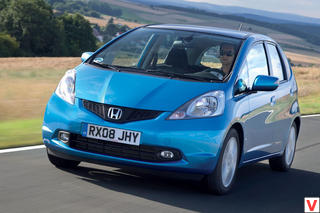
The second generation Jazz appeared in 2009. The new platform, redesigned, improved engines - this is by no means a complete list of the characteristics that distinguish the second generation Honda Jazz. Given that the previous generation managed to glory, the designers tried to avoid revolutionary alterations.
The car became a full-fledged successor to the previous generation - both the style and the concept remained. Clearly following the trends of recent years, the second-generation Jazz has grown a bit in size. Numerically, this is expressed as follows: the length has grown to 3900 mm (+55 mm), and the width to 1695 mm (+20). The wheelbase increased by 50 mm, front track increased by 35 mm, rear - by 30 mm. The main difference of the second generation Jazz from the previous modification of the Japanese compact can be seen in the front of the body, which has become more expressive and expressive, and also received an updated grille, made in the style of the Civic model.
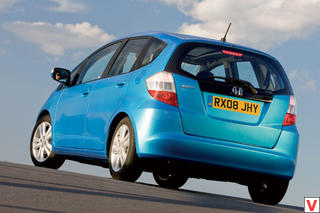
The second-generation Honda Jazz is still the same practicality and versatility. Compact and ergonomic dashboard has retained the characteristic features of its predecessor, but it looks completely different. In particular, the original levers, which were in charge of the first-generation Jazz with music and climate control settings, gave way to more traditional, but more convenient buttons, grouped in two round sections. In addition, the audio installation itself has changed. Modernization has not bypassed the instrument cluster. Previously, the three main dials were hidden in separate wells - now they have only a tachometer and fuel gauge.
And the speedometer scale increased in size was placed under the common visor with the on-board computer display. A pointer appeared next to the tachometer, telling when it is better to shift the gear so that the fuel consumption is minimal. In general, the information content of the instrument cluster has become noticeably better. Not to mention the new three-spoke steering wheel.
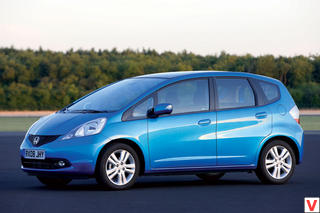
The small diameter and fairly thick rim make it very comfortable. The increased length of the car added comfort to rear row passengers. To facilitate access to the second row of seats, the opening angle of the rear doors was increased to 80 degrees. Behind, as in the first generation car, are the Magic Seat seats. Japanese designers paid special attention to visibility salon.
The result was a car with thin side pillars and a reduced “dead zone”, which greatly increased the safety performance of the Jazz model. In addition, such constructive solutions allowed to create a car with a large glass area. Under the floor cover of a roomy trunk (399 l), there are many different niches and compartments for accommodating 60 liters of various shaped objects. And if it becomes necessary to take on board a larger load, it is enough to fold the back row of seats in order to provide additional storage space.
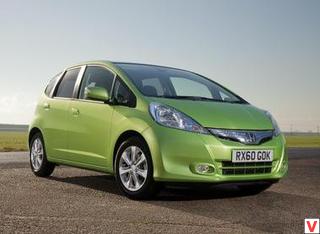
For Jazz, the second generation created, in fact, a new engine: reworked the cylinder head (four valves per cylinder now), improved the cooling system, reworked the shape of the combustion chamber, reduced friction in the cylinder-piston group, modified the intake and exhaust. As a result, at the same volume of 1.4 liters, the return increased to a very decent 100 hp. (The 1.2-liter 90-strong version will also be sold in Europe). The five-speed "mechanics", in contrast to the engine, did not change so seriously - it only revised a number of gear ratios and improved the synchronizers. From the variator refused, justifying this environmental considerations.
In its place came the i-Schift robotic box. Fuel consumption averages 5.1 liters per 100 kilometers, the CO2 content in the exhaust does not exceed 120 g / km. The suspension scheme has not changed - McPherson struts in the front and a semi-dependent rear beam - but the suspension settings have been revised, and the track has been increased. In addition, now instead of the previous 14-inch wheels on the basic version are 15-inch (equipment "Sport" is equipped with wheels 16 "). As a result, the behavior of the car on the road has become even more reliable and exciting.
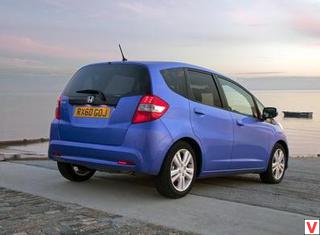
The basic equipment of the new Jazz includes ABS, VSA stabilization system, front seat belt pretensioners, eight airbags, audio, climate control, and the most expensive version even has a full-fledged panoramic roof. All wheel brakes are disc. The Sport package features a special front bumper shape and an aerodynamic skirt. The official debut of the updated Honda Jazz hatchback of the 2011 model year occurred at the Geneva Auto Show. The manufacturer announced a return to the automatic transmission CVT and the infinite possibilities of transformation of the cabin. Significant changes in appearance has not undergone.
The car has received new headlights, new bumpers, rear LED lights. Due to the redesigned bumpers Jazz became more streamlined in shape, which had a positive impact on the drag coefficient. An elongated base for the wheels provides more space for passengers and the driver, and a short front and smaller rear parts give the car maneuverability on the road and eliminate parking problems.
The model has received two new colors blue Deep Sapphire Blue and bronze Ionized Bronze. Updated and a number of available for order alloy wheels. Interior design, in comparison with the previous version, has not received any major changes.
The location of the elements of the dashboard still pleases practicality and convenience. Changed colors steering wheel and center console. In general, the interior of the updated Honda Jazz received a darker design. The blue illumination of the center console and dashboard stands out brightly. It is worth noting the new navigation system that uses to store information modern SSDs, as well as Bluetooth and entertainment system for the rear passengers. For the European model restyled version is available and leather interior.
The luggage compartment of the Honda Jazz 2011 fully confirms the manufacturer's statement about the wonderful transformations of the passenger compartment, because in a couple of simple movements a small trunk turns into a spacious cargo compartment. This is due to the Magic Seats' seat design, which is folded in parts and forms a flat floor when folded. Now a few words about the engine range for the updated Jazz. The car received a modern 1.2 liter gasoline engine with a power of 90 hp, as well as a 1.4 liter gasoline engine of 100 hp.
If the most modest engine is offered only with 5-speed mechanics, then the 1.4-liter engine can be aggregated with the new CVT variator, which is a hybrid of the torque converter and the variator. It combines completely opposite concepts - inherent in “automata” simplicity of control and economy in work. The clutch pedal is missing, so this gearbox significantly increases engine life. Honda Jazz 2011 is offered in three trim levels. The basic version will include eight airbags, ABS, stabilization system, immobilizer, rear-view mirrors with heating and electric adjustment, power windows, air conditioner and MP3-radio with two speakers and a USB input.
The complete set Elegance additionally included heated front seats, climate control and two more speakers audio. And the most expensive version of the Executive will be able to boast of foglights, a panorama of the roof, light and rain sensors, a leather steering wheel, a glove box with cooling and an alarm system. Honda Jazz 2011 is also available in the Hybrid version. The hybrid model features a new bright green color Lime Green and a chrome grille. Special attention is given to the fact that the batteries of the hybrid version were installed without damage to the size of the cabin.
The car has retained the design of seats called Magic Seats, thanks to the transformation of which the luggage compartment volume can easily be increased from an average size of 300 liters (the luggage compartment of the gasoline Jazz is 399 liters) to a huge 1,390 liters with a flat floor. The Honda IMA (Integrated Motor Assist) system combines the power of a 1.3 liter 88-horsepower gasoline engine, as well as an electric motor of 14 hp. with a CVT variator. Jazz Hybrid is able to accelerate to 100 km / h in 12.6 seconds, and the maximum speed is 177 km / h, fuel consumption is only 4.5 liters per 100 km.
And among other things, the Japanese manufacturer promises that the amount of CO2 emissions while driving will be 104 g / km.
